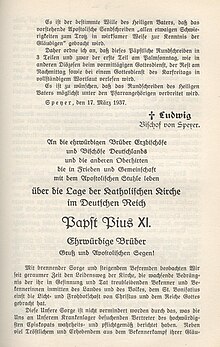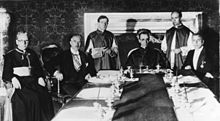| الاسم الأصل | |
|---|---|
| النوع الفني | |
| المُؤَلِّف | |
| لغة العمل أو لغة الاسم | |
| بتاريخ | |
| تاريخ النشر |

Mit brennender Sorge (وصلة=| عن هذا الصوت ⓘ تُلفظ بالألمانية: [mɪt ˈbʀɛnəndɐ ˈzɔʁɡə] ، «بقلق») على الكنيسة والرايخ الألماني هو منشور من البابا بيوس الحادي عشر، صدر خلال الحقبة النازية في 10 مارس 1937 (ولكنه يحمل تاريخ الأحد العاطفي، 14 مارس).[1] مكتوب بالألمانية، وليس اللاتينية المعتادة، تم تهريبه إلى ألمانيا خوفًا من الرقابة وتم قراءته من منابر جميع الكنائس الكاثوليكية الألمانية في أحد أكثر أيام الكنيسة ازدحامًا، أحد الشعانين (21 مارس من ذلك العام).[2] [3]
أدان المنشور الخرق لاتفاق الرايشكونكوردات لعام 1933 الموقع بين الرايخ الألماني والكرسي الرسولي.[4] وأدانت «ارتباك وحدة الوجود» و «وثنية جديدة» و«ما يسمى بأسطورة العرق والدم» ووثن الدولة. احتوت على دفاع قوي عن العهد القديم مع الاعتقاد بأنها تمهد الطريق للجديد.[5] تنص الرسالة العامة على أن العرق هو قيمة أساسية للمجتمع البشري، وهو أمر ضروري ومُشرِف لكنه يدين تمجيد العرق، أو الشعب، أو الدولة، فوق قيمتها المعيارية إلى مستوى وثني.[6] ويعلن المنشور «أن الإنسان بصفته إنساناً يمتلك حقوقاً يمتلكها من الله، والتي يجب أن تحميها أي جماعة من الإنكار أو القمع أو الإهمال».[7] لم يتم ذكر الاشتراكية القومية، أدولف هتلر والحزب النازي في الوثيقة. بل أستخدم مصطلح الحكومة الألمانية (Reichsregierung).[8]
كانت محاولة إنتاج وتوزيع أكثر من 300000 نسخة من الرسالة سرية تمامًا، مما سمح للكهنة في جميع أنحاء ألمانيا بقراءة الرسالة دون تدخل.[9] داهم الغيستابو الكنائس في اليوم التالي لمصادرة جميع النسخ التي يمكنهم العثور عليها، وتم إغلاق المطابع التي طبعت الرسالة. وفقا للمؤرخ إيان كيرشو، بدأ تكثيف النضال العام ضد الكنيسة حوالي أبريل استجابة للرسالة.[10] كتب شولدر: «رد فعل مسؤولي الدولة والحزب بغضب واستنكار. ومع ذلك، لم يأت الانتقام الكبير الذي كان يُخشى. ظلت الكونكوردت سارية، وعلى الرغم من كل شيء، اشتدت المعركة ضد الكنيستين التي بدأت بعد ذلك ضمن الحدود العادية».[11] كما حد النظام من تصرفات الكنيسة وضايق الرهبان بمحاكماتهم.[12] على الرغم من أن هتلر لم يذكر اسمه في الرسالة العامة، إلا أنه يشير إلى «نبي مجنون» يقول البعض إنه يشير إلى هتلر نفسه.[13]
خلفية

بعد الاستيلاء النازي، حاول التسلسل الهرمي للكنيسة الكاثوليكية في ألمانيا في البداية التعاون مع الحكومة الجديدة، ولكن بحلول عام 1937 أصبح محبطًا للغاية. كان هناك تهديد، على الرغم من أن الاضطهاد المتقطع في البداية للكنيسة الكاثوليكية يتبع الاستيلاء النازي.[14] تحرك هتلر بسرعة للقضاء على الكاثوليكية السياسية. اعتقلت الشرطة ألفي موظف من حزب الشعب البافاري في أواخر يونيو 1933، وتوقف هذا الحزب مع حزب المركز الكاثوليكي الوطني في أوائل يوليو. في هذه الأثناء، تفاوض نائب المستشار فرانز فون بابن على معاهدة الرايشكونكوردات مع الفاتيكان، والتي منعت رجال الدين من المشاركة في السياسة.[15] وكتب كيرشو أن الفاتيكان كان حريصًا على التوصل إلى اتفاق مع الحكومة الجديدة، على الرغم من «التحرش المستمر برجال الدين الكاثوليك، والاعتداءات الأخرى التي يرتكبها المتطرفون النازيون ضد الكنيسة ومنظماتها».[16]
انظر أيضا
- الدين في ألمانيا النازية
- الوحدة الإنسانية
- Summi Pontificatus
المراجع
- ^ "Church and state through the centuries", Sidney Z. Ehler & John B Morrall, pp. 518–519, org pub 1954, reissued 1988, Biblo & Tannen, 1988, (ردمك 0-8196-0189-6)
- ^ Anton Gill; An Honourable Defeat; A History of the German Resistance to Hitler; Heinemann; London; 1994; p.58
- ^ "Before 1931 all such messages [encyclicals] were written in Latin. The encyclical Non abbiamo bisogno of June 29, 1931, which condemned certain theories and practices of Italian Fascism, particularly in the realm of education, and denounced certain treaty violations of Signor Mussolini's Government, was the first document of that kind that appeared in a language other than Latin." The Catholic Herald, "First Encyclical in German", PAGE 3, 9 April 1937 "نسخة مؤرشفة". مؤرشف من الأصل في 2014-05-27. اطلع عليه بتاريخ 2020-04-16.
{{استشهاد ويب}}: صيانة الاستشهاد: BOT: original URL status unknown (link) - ^ Robert A.Ventresca – p.iv of photos, Soldier of Christ
- ^ Paul O'Shea, A Cross too Heavy, p.156-157
- ^ Martin Rhonheimer, The Holocaust: What Was Not Said, First Things 137 (November 2003): 18–28
- ^ Mit brennnder Sorge, § 30 in English version نسخة محفوظة 7 أكتوبر 2019 على موقع واي باك مشين.
- ^ Mit brennender Sorge Para 3
- ^ The Roman Catholic periodical The Tablet reported at the time "The Encyclical, which took the Nazi Government completely unawares, had been introduced into Germany by the diplomatic bag to the Nunciature, and Monsignor Orsenigo, Apostolic Nuncio in Berlin had arranged for its secret distribution all over the country so that it was read in every Catholic church of the Reich last Sunday, before the Government had time to confiscate and suppress it.", The Tablet, 3 April 1937, p.10 "نسخة مؤرشفة". مؤرشف من الأصل في 2018-04-26. اطلع عليه بتاريخ 2020-04-16.
{{استشهاد ويب}}: صيانة الاستشهاد: BOT: original URL status unknown (link) - ^ Ian Kershaw; Hitler a Biography; 2008 Edn; WW Norton & Company; London; p. 381–382
- ^ Scholder, p. 154-155
- ^ The Catholic periodical The Tablet reported shortly after the issuing of the encyclical "The case in the Berlin court against three priests and five Catholic laymen is, in public opinion, the Reich's answer to the Pope's Mit brennender Sorge encyclical, as the prisoners have been in concentration camps for over a year. Chaplain Rossaint of Dusseldorf is, however, known as a pacifist and an opponent of the National Socialist regime, and it is not denied that he was indiscreet; but he is, moreover, accused of having tried to form a Catholic-Communist front on the plea that he baptized a Jewish Communist. This the accused denies, and his defence has been supported by Communist witnesses", The Tablet, p. 13, 24 April 1937
- ^ McGonigle, p. 172: "the encyclical Mit brennender Sorge was read in Catholic Churches in Germany. In effect it taught that the racial ideas of the leader (Führer) and totalitarianism stood in opposition to the Catholic faith; Bokenkotter, pp. 389–392; Historian Michael Phayer wrote that the encyclical doesn't condemn Hitler or National Socialism, "as some have erroneously asserted" (Phayer, 2002), p. 2; "His encyclical Mit brennender Sorge was the 'first great official public document to dare to confront and criticize Nazism' and even described the Führer himself as a 'mad prophet possessed of repulsive arrogance.'"; Rhodes, pp. 204–205: "Mit brennender Sorge did not prevaricate... Nor was the Führer himself spared, for his 'aspirations to divinity', 'placing himself on the same level as Christ': 'a mad prophet possessed of repulsive arrogance' (widerliche Hochmut)."; "It was not the case that Pius failed to "spare the Führer," or called him a "mad prophet possessed of repulsive arrogance." The text limits its critique of arrogance to unnamed Nazi "reformers" (John Connelly, Harvard University Press, 2012, "From Enemy to Brother: The Revolution in Catholic Teaching on the Jews, 1933–1965", p. 315, fn 52)
- ^ Ian Kershaw; Hitler a Biography; 2008 Edn; W.W. Norton & Company; London; p.332
- ^ Ian Kershaw; Hitler a Biography; 2008 Edn; W.W. Norton & Company; London; p.290
- ^ Ian Kershaw; Hitler a Biography; 2008 Edn; WW Norton & Company; London; p.295
مصادر
- Bokenkotter، Thomas (2004). A Concise History of the Catholic Church. Doubleday. ISBN:0-385-50584-1. مؤرشف من الأصل في 2022-05-31.
- Chadwick، Owen (1995). A History of Christianity. Barnes & Noble. ISBN:0-7607-7332-7.
- Coppa، Frank J. (1999). Controversial Concordats. Catholic University of America Press. ISBN:978-0-8132-0920-3. مؤرشف من الأصل في 2021-03-08.
- Courtois، Stéphane؛ Kramer, Mark (1999). The Black Book of Communism. Harvard University Press. ISBN:978-0-674-07608-2.
- Duffy، Eamon (1997). Saints and Sinners, a History of the Popes. Yale University Press. ISBN:0-300-07332-1. مؤرشف من الأصل في 2022-04-07.
- Falconi، Carlo (1967). The Popes in the Twentieth Century. Feltrinelli Editore. 68-14744.
- McGonigle (1996). A History of the Christian Tradition: From its Jewish roots to the Reformation. Paulist Press. ISBN:978-0-8091-3648-3.
- Norman، Edward (2007). The Roman Catholic Church, An Illustrated History. University of California Press. ISBN:978-0-520-25251-6. مؤرشف من الأصل في 2022-04-28.
- Shirer، William L. (1990). The Rise and Fall of the Third Reich. Simon and Schuster. ISBN:978-0-671-72868-7.
- Pham، John Peter (2006). Heirs of the Fisherman: Behind the Scenes of Papal Death and Succession. Oxford University Press. ISBN:0-19-517834-3. مؤرشف من الأصل في 2021-04-19.
- Phayer، Michael (2000). The Catholic Church and the Holocaust, 1930–1965. Indiana University Press. ISBN:0-253-21471-8. مؤرشف من الأصل في 2022-07-26.
- Rhodes، Anthony (1973). The Vatican in the Age of the Dictators (1922–1945). Holt, Rinehart and Winston. ISBN:0-340-02394-5.
- Shirer، William L. (1990). The Rise and Fall of the Third Reich. Simon and Schuster. ISBN:978-0-671-72868-7.
- Vidmar، John (2005). The Catholic Church Through the Ages. Paulist Press. ISBN:0-8091-4234-1. مؤرشف من الأصل في 2022-04-10.
- Scholder، Klaus (1989). Requiem For Hitler. SCM Press. ISBN:0334022959. مؤرشف من الأصل في 2021-03-08.
- Peter Rohrbacher (2016). The Race Debate in the Curia in the Context of “Mit brennender Sorge” In: Fabrice Bouthillon, Marie Levant (Hrsg.): Un pape contre le nazisme? L'encyclique "Mit brennender Sorge" du pape Pie XI. (14 mars 1937). Actes du colloque international de Brest, 4–6 juin 2015. Editions Dialogues, Brest 2016, S. 93–108.








